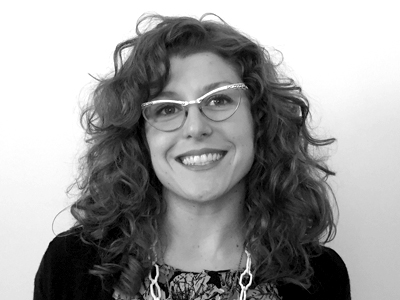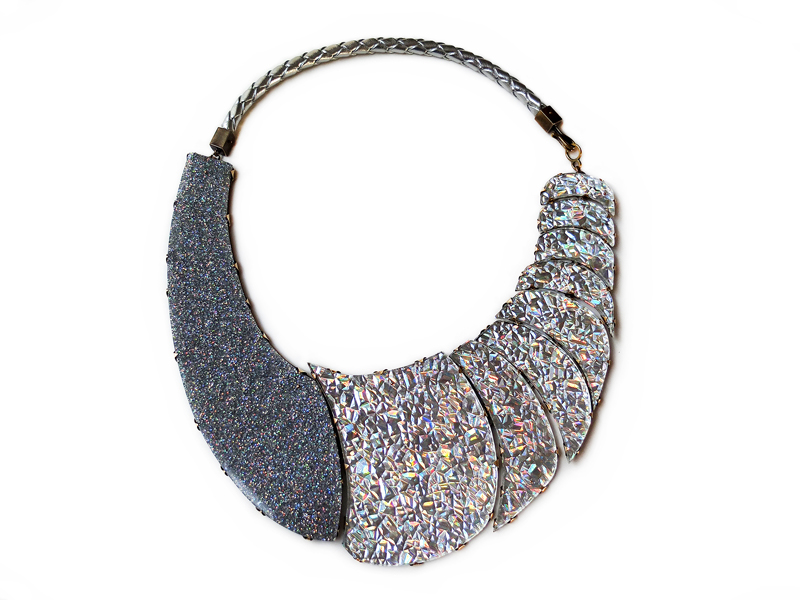
The jewelry of Oakland-based Florida native Nikki Couppee employs vibrant colors and illusory surfaces that simultaneously evoke preciousness while coyly giving it the finger. In this conversation, Couppee discusses the underlying nostalgic impulses and material fascinations in her latest show, Hologems, on view at Velvet da Vinci May 11–June 19, 2016.
Adriane Dalton: Tell us a bit about your background. What sparked your initial interest in jewelry, and where were you trained?
Nikki Couppee: Growing up, I made a lot of friendship bracelets and hemp pieces. When I was in middle school, a hurricane destroyed much of the area; the entire island was washed over. I would go around and pick through the remains of peoples’ washed-away houses and find broken shards of glass, plates, and other bits and pieces. I would make mosaics on washers, paint little scenes on the bolts I borrowed from the houses under construction, and make jewelry pieces out of all of it.
I started taking metals classes in high school when I did early admissions at the local college, Pensacola State in Pensacola, Florida. I took a jewelry course as an elective because I liked making jewelry as a kid and wanted to learn to work with metal and big stones because that’s what I wanted to wear. I fell in love with the class and learned cloisonné enameling from my teacher, Doug Reiser. Cloisonné opened up a lot of creative doors for me. It combined my interest in drawing and painting with my interest in stones, and then could be made into jewelry. I received an AA from Pensacola State in 2003 and transferred to the University of Georgia in Athens, Georgia, where I studied with Rob Jackson and Mary Hallam Pearse, earning a BFA in jewelry/metals in 2007. I completed my MFA in jewelry/metals with Kathleen Browne at Kent State University, in Kent, Ohio, in 2011.
How many pieces are on display in Hologems, and how long have you been working on this exhibition?
Nikki Couppee: There are around 40 pieces in this show, and I’ve been preparing for over six months by continually experimenting with combining different synthetic materials and resins. I also became interested in the craft and materials of fly-fishing. I took a class to learn fly-tying and to become familiar with all the different fibers and threads used to make flies.

Can you tell us about the inspiration for the show and about its title, Hologems? Is this body of work meant as a comment on the aesthetics of your materials as well as on traditional value systems associated with jewelry?
Nikki Couppee: From the beginning of culture, a person’s position within society could be understood by how they adorned their body. The intrinsic value of the materials used in jewelry making has always been a reflection of an individual’s or family’s wealth. Even today only the social elite have the chance to wear extravagant and expensive jewelry. In my work, I want to create opulent jewelry using my own version of gemstones made from everyday materials instead of precious stones and metals. Plexiglas and brass are employed to create industrial counterfeits or stand-ins for the real thing.
By highly exaggerating the size and abundance of “gemstones” in my work, I can parody or poke fun at the class issues inherent in fine jewelry. With the use of everyday materials, I am able to make jewelry that surpasses in size and extravagance the royal jewels I admire, almost to the point of absurdity.
Hologems refers to the holographic material made into gemstones. I use holograms and faux silver foil underneath the “stones” to add luster, referencing paste diamonds and rhinestones.
You name among your inspirations Floridian beaches, the 1980s, and 17th-century royal jewelry. Are you saying you have a penchant for the gaudy? Or is it sartorial fearlessness?
Nikki Couppee: I was born in the 80s and grew up as a 90s kid on a small barrier island in Florida. My work, at its core, is influenced by historical and royal jewelry from the 17th, 18th, and 19th centuries. When I began working with synthetic materials, they were so bright and sparkly they reminded me a lot of toys and the details of things I enjoyed when I was little: Barbie, Troll doll hair, Lisa Frank stickers, My Little Pony, unicorns, and anything Keroppi. Because I occasionally feel homesick from living on the West Coast for the past four years, I decided to make work reminiscent of the beach and growing up there. I chose materials like synthetic fishing ties, holograms, fake plastic flowers, glow-in-the-dark bits, plastic sugar sprinkles like my mom’s Christmas decorations from the 60s, all in a color palette that relates what I remember. When I was a kid I got a plastic glow-in-the-dark Mary statue, I think for my first communion. I have always moved with it and enjoy its glow when I turn off the lights. I wanted to make fun, glowing pieces reminiscent of that.
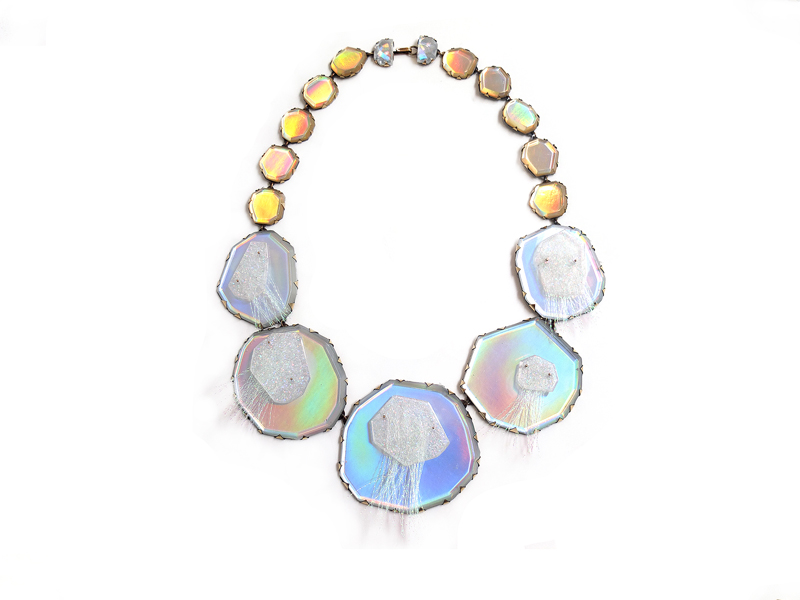
You currently reside in the Bay Area. Does your work also have a resonance with your current location? Do you predict a similar nostalgic/reflective influence in future bodies of work?
Nikki Couppee: A lot of my work is about the emotional life of jewelry and how it can tap into your innermost feelings. Psychologically, jewelry functions on an emotional level; it has the ability to evoke memories from one’s personal or family history. Jewelry is often given to mark a special occasion or milestone and, because of the emotions attached to such occasions, deep feelings are often transferred to the jewelry, making them highly charged objects. When I was growing up, my mom marked milestones and achievements with a gifted piece of jewelry—either from her collection, an heirloom, or new. The memories associated with each piece tell a story, and now I like to create work based off my own memories.
Describe your creative process. How do you acquire your materials and how do you approach composition?
Nikki Couppee: I source materials from everywhere and anywhere: the ground, thrift shops, costume jewelry, and old craft supplies given to me by friends. I cut things out of clothes and shoes; I source plastics and make my own acrylic colors as well—really anything colorful or shiny that strikes me is a possibility. I like to have a lot of different things to pull from, and when I make a piece I pick from little piles to build it up until it feels cohesive. I like working with asymmetry to create a conversation in the work so what one part lacks another has, and vice-versa. Whether worn casually or for dressy occasions, this work commands attention because of its size and the seemingly familiar yet unfamiliar materials used. With each design I have carefully considered the placement on the body and how that might affect the wearer. Though the majority of the works are large in scale, they have the same comfort of smaller pieces of jewelry and are light because of the materials used.
Many of your compositions seem to nod toward the natural world. For example, I read the forms in the Midnight Cocktail Earrings or Corsage Brooch as seaweed, coral, flora, sunsets, and the galaxy. The synthetics create a “nature by way of costume jewelry” opulence. Can you expound upon the implicit and explicit themes at play in these works?
Nikki Couppee: My intent with this body of work was to examine jewelry in relation to value, class, and emotional connection. My strategy for accomplishing this was to substitute mundane materials for precious gems and metals in hope of giving access to such luxuries to a broader audience. I want to create works reminiscent of historical and royal jewelry but which are more accessible to the average person, myself included. This sentimental jewelry, much like mourning jewelry made popular by Queen Victoria in the 19th century, utilizes alternative, low-cost materials to produce pieces more people can afford and use as a vehicle to express emotion outwardly through personal adornment.
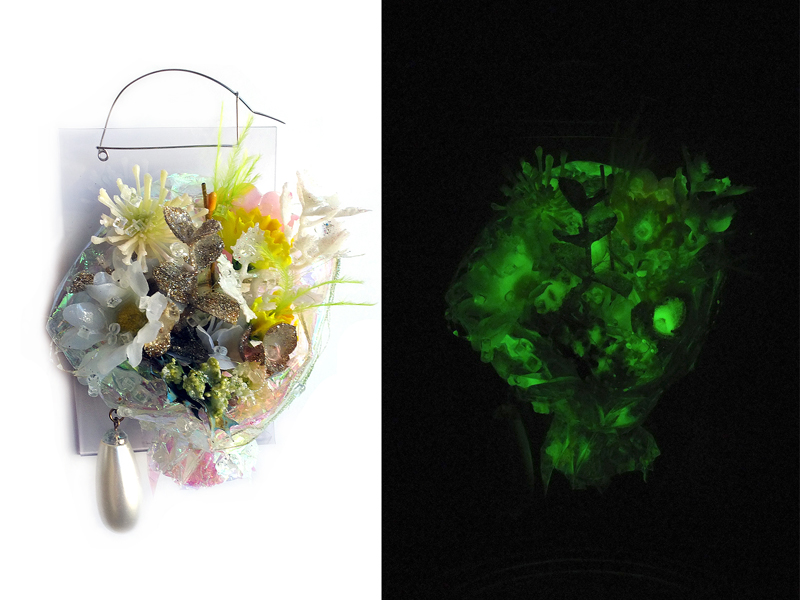
Your work is affiliated to both contemporary and costume jewelry. Glitter thrives in both worlds, but probably with different connotations. Do you think that’s true, and does it matter to you?
Nikki Couppee: I think glitter performs the same in both worlds. I grew up making crafty cards with glitter and now I like using it in my jewelry. It is nostalgic and has a childish connotation. It catches your eye and that is why I really like it.
Asymmetry features prominently in your work, particularly in your earrings. I happen to favor asymmetrical earrings but I’m curious to know how consumers who might be accustomed to traditional jewelry forms respond?
Nikki Couppee: I think it often depends on if the person wears art jewelry already, but I have found the fine jewelry wearer appreciates my work too, which I think is really exciting. The sparkly, gem-like elements are eye-catching and seem to attract the attentions of lots of different people.
Your artist statement cites an intention to challenge the performative social function of jewelry. Can you elaborate on this challenge and how you communicate it through the work?
Nikki Couppee: Objects of personal adornment have the ability to define a person’s social status, to serve as redeemable investments, and to perform on a psychological level. I like challenging these ideas by making work that resembles historical precious gem jewelry with vivid colors and sparkling facets made from plastics and found objects.

What is it like to be a working artist in a region increasingly known for inflated rents and a tech startup-driven economy?
Nikki Couppee: I live in Oakland in a rent-controlled house and feel very lucky to have it. The Bay Area is the most expensive place I have lived so far. However, on the flip side, my work does sell well here because people have disposable income; they appreciate and buy art jewelry. I have only been here for a couple years so my knowledge of the area and how it used to be is limited and I do wish I could have experienced it 10 or 15 years ago!
I work from home because studio rentals are expensive. I hope to make connections over time and find an affordable space eventually, but for now I am making it work. I hear many stories of people being displaced, being forced to move because of escalated rent prices. It is distressing and discouraging, to say the least. It is an easy place to feel unstable in, and I sometimes feel my time is limited, so I am enjoying it now and feel incredibly grateful.
What are some of the challenges you’ve experienced while building a career as an art jeweler?
Nikki Couppee: Wanting more space to work in and equipment are the big things for me. Finding balance is always hard, too. I never want to miss an opportunity but sometimes I take on too much and I feel pulled thin.
What projects do you have in the works? Any forthcoming publications or other shows planned?
Nikki Couppee: I am assisting Elizabeth Turrell’s enameling workshop at Penland School of Crafts this summer and I am so excited. I also will be in a group show, Funny Business, at Facèré Jewelry Art Gallery in July. I am also excited about the poured resin elements I made for Hologems and want to continue to experiment to make more complex brooches and necklaces.
The work in this exhibition ranges in price from $200 to $1,300.
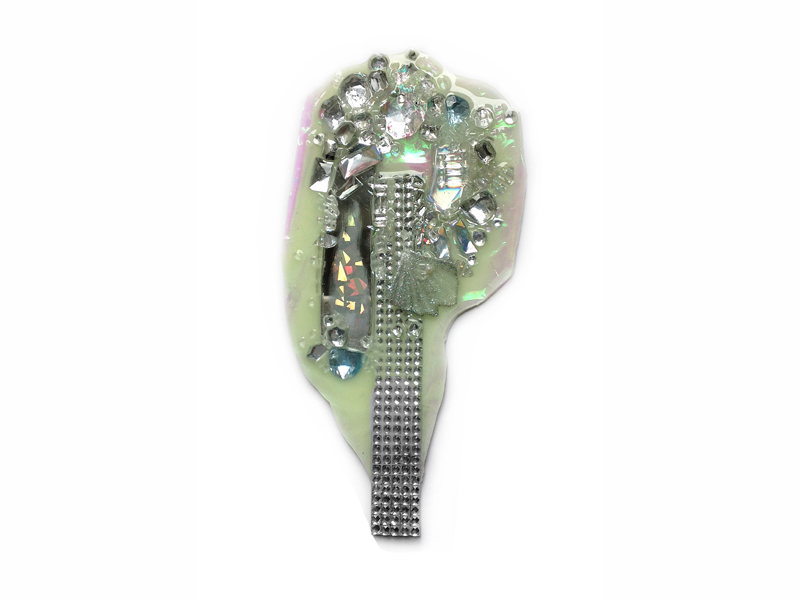
INDEX IMAGE: Nikki Couppee, Midnight Cocktail Earrings, 2015, Plexiglas, brass, sterling silver, fine silver, found objects, 102 x 51 x 13 mm, photo: artist
